Research on the Recyclable Design of Wooden Furniture Based on the Recyclability Evaluation
Abstract
1. Introduction
2. Theoretical Background and Research Significance
2.1. Recycling and Utilization of Waste Furniture
2.2. Recyclable Design of Wooden Furniture
2.3. Evaluation Study on Recyclability of Wooden Furniture
2.4. Life Cycle of Wooden Furniture Products
2.5. Research Significance
2.5.1. Focusing on Recyclable Design
2.5.2. Systematically Analyzing the Recycling of Discarded Furniture
2.5.3. Strengthening the Evaluation Criteria on Recyclability
3. Research Methodology
3.1. Construction of Evaluation Index System
3.2. Establishment of Evaluation Model
- (1)
- Normalize the matrix according to the following equation:
- (2)
- Construct the fuzzy positive ideal solution and the fuzzy negative ideal solution as follows, respectively:
- (3)
- Calculate the distance between each alternative and the positive and negative ideal solution:
- (4)
- The evaluation results given to the participants are as follows:
4. Results
4.1. Wooden Furniture Recycling Case Study
- (1)
- Weight distribution. According to the above steps, the factors in the evaluation index set are scored for relative importance, and a priority relationship matrix is constructed. compares the economic benefits, environmental impacts, and technical processing difficulties contained in the first tier of indicators, classify and compare those contained in the second tier of indicators, and the priority relationship matrix is as follows:
- (2)
- TOPSIS Evaluation
4.2. Application Scenarios of Recyclability Evaluation
4.2.1. Development of Furniture Recovery and Disposal Center
4.2.2. The Establishment of a Strategic Alliance for Recycling Discarded Furniture
5. Discussion
6. Conclusions
Author Contributions
Funding
Institutional Review Board Statement
Informed Consent Statement
Data Availability Statement
Acknowledgments
Conflicts of Interest
References
- Zhu, J.; Wu, Z. Technology System for Green Manufacturing in Furniture Industry 6th: Green Packaging and Recycling Technology. Furniture 2013, 34, 73–77. [Google Scholar] [CrossRef]
- Lin, C.-W.R.; Chen, M.-T.; Tseng, M.-L.; Chiu, A.S.F.; Ali, M.H. Profit Maximization for Waste Furniture Recycled in Taiwan Using Cradle-to-Cradle Production Programming. Math. Probl. Eng. 2020, 2020, 2948049. [Google Scholar] [CrossRef]
- Xiong, X.; Ma, Q.; Yuan, Y.; Wu, Z.; Zhang, M. Current situation and key manufacturing considerations of green furniture in China: A review. J. Clean. Prod. 2020, 267, 121957. [Google Scholar] [CrossRef]
- Kang, H.; Cao, G.; Zhao, C. Multifunctional furniture design based on product life cycle. Packag. Eng. 2018, 39, 39–43. [Google Scholar] [CrossRef]
- Hu, S.; Tao, T. Recycling of abandoned wooden furniture. Furnit. Inter. Des. 2006, 13, 18–19. [Google Scholar] [CrossRef]
- Huang, R.; Bao, F.; Huang, X. Current situation of wood resource recycling in Japan. World For. Res. 2006, 19, 69–75. [Google Scholar] [CrossRef]
- Daian, G.; Ozarska, B. Wood waste management practices and strategies to increase sustainability standards in the Australian wooden furniture manufacturing sector. J. Clean. Prod. 2009, 17, 1594–1602. [Google Scholar] [CrossRef]
- Tapia, J.F.D.; Promentilla, M.A.B.; Tseng, M.-L.; Tan, R.R. Screening of carbon dioxide utilization options using hybrid Analytic Hierarchy Process-Data Envelopment Analysis method. J. Clean. Prod. 2017, 165, 1361–1370. [Google Scholar] [CrossRef]
- GB/T 22529-2008; Management Code for Discarded Wooden Recycling and Utilization. Standards Press of China: Beijing, China, 2008.
- Liu, M.; Zhou, Y.; Ma, Y. Recycling utilization and treatment technology for the city abandons wood. Guangdong For. Sci. Technol. 2010, 26, 55–59. [Google Scholar]
- Huang, B.; Zhao, M.; Wang, Y.; Yang, J.; Zhang, J. Recycle and Reuse of Discarded Wooden Furniture:Taking Changsha City as An Example. Furnit. Inter. Des. 2012, 19, 88–89. [Google Scholar] [CrossRef]
- Xiong, X.; Yue, X.; Dong, W.; Xu, Z. Current status and system construction of used-furniture recycling in China. Environ. Sci. Pollut. Res. Int. 2022, 29, 82729–82739. [Google Scholar] [CrossRef]
- Mao, Y.; Li, M.; Wu, Z. Recycling and Value-added Design of Old Wooden Furniture. Packag. Eng. 2015, 36, 14–17. [Google Scholar] [CrossRef]
- Wang, H.; Li, C. Discuss the recycling and useage of rural used furniture. Furnit. Inter. Des. 2011, 18, 52–53. [Google Scholar] [CrossRef]
- Lee, B.; McDonald, A. Wood fibre-plastic composite materials for injection moulding. In Proceedings of the 5th Pacific Rim Biobased Composites Symposium, Canberra, Australia, 10–13 December 2000; pp. 10–13. [Google Scholar]
- Zhang, J. Wood recycling is booming in Europe. China For. Ind. 2005, 2, 30–32+38. [Google Scholar]
- Tansey, P. Valentins way. Wood Based Panels Int. 1994, 5, 30–33. [Google Scholar]
- Wang, X. Research on Manufacturing Technology of Recycled Particleboard. Master’s Thesis, Beijing Forestry University, Beijing, China, 2008. [Google Scholar]
- Chen, L. Technology status and development prospect of wood ceramics. J. Bijie Univ. 2014, 32, 90–94. [Google Scholar]
- Li, J.; Hou, X.; Du, Y.; Liu, S.; Yuan, Z.; Gao, Z. Research progress on recycling of waste artificial board. For. Sci. Technol. 2019, 44, 55–58. [Google Scholar] [CrossRef]
- Üner, B.; Köse, G.; Yürümez, Y.; Ümit Yalçın, Ö.; Akgül, M. Wood Waste Turned Into Value Added Products: Thermal Plasticization by Benzylation Process. Drv. Ind. 2017, 67, 315–322. [Google Scholar] [CrossRef]
- Oh, S.W.; Okabe, T. Manufacture of woodceramics chip tiles from waste wood. For. Prod. J. 2003, 53, 50. Available online: https://www.proquest.com/docview/214629388?pq-origsite=gscholar&fromopenview=true (accessed on 26 August 2023).
- He, X.; Mu, Y. Discussion on recycling and utilization of wasting wood-based panels. Wood Process. Mach. 2008, 1, 50–53. [Google Scholar] [CrossRef]
- Cao, H.; Wang, H. Research progress of preparation and refining of wood vinegar. Guangdong Chem. Ind. 2014, 41, 37–38. [Google Scholar]
- Wiltcher, D.; Borazjani, H.; Diehl, S.V.; Stewart, H.A. Composting of phenolic-bonded softwood plywood waste. For. Prod. J. 2000, 50, 82. Available online: https://www.proquest.com/docview/214643199?pq-origsite=gscholar&fromopenview=true (accessed on 26 August 2023).
- Fu, Y.; Wan, Y.; Tang, L. Design of slow/controlled release fertilizer shell prepared from wood residues. Pract. For. Technol. 2010, 53, 50–52. [Google Scholar] [CrossRef]
- Ceschin, F.; Gaziulusoy, İ. Design for Sustainability: A Multi-Level Framework from Products to Socio-Technical Systems; Routledge: London, UK, 2019. [Google Scholar]
- Hebrok, M. Where Furniture Goes to Die. Designing for Sustainable Behaviour in a Practice Perspective. Tech. Cult. Rev. Semest. D’anthropologie Tech. 2016. [Google Scholar] [CrossRef]
- Wang, S. Research on Sustainable Design of Typical Furniture. Master’s Thesis, Harbin Engineering University, Harbin, China, 2014. [Google Scholar]
- Yang, C.; Sun, W. Sustainable design combining “new materials” and innovative design methods. Light Ind. Sci. Technol. 2015, 31, 114–116. [Google Scholar]
- Zhu, X. The Application of Opal System Furniture in Interior Design. Furniture 2001, 22, 38–39. [Google Scholar] [CrossRef]
- Wang, D.; Wang, F. Study on Design Methods for Furniture Mass Customization. Furnit. Inter. Des. 2005, 26–29. [Google Scholar] [CrossRef]
- Deng, J. The Research of Modularized Design of Furniture Based on PLM. Master’s Thesis, Guangdong University of Technology, Guangzhou, China, 2013. [Google Scholar]
- Fujii, M.; Fujita, T.; Ohnishi, S.; Yamaguchi, N.; Yong, G.; Park, H.-S. Regional and temporal simulation of a smart recycling system for municipal organic solid wastes. J. Clean. Prod. 2014, 78, 208–215. [Google Scholar] [CrossRef]
- Li, S.; Chen, M.; Lyu, J. User-based Furniture Recycling System Innovation and Its Implementation. In Proceedings of the 2016 5th International Conference on Sustainable Energy and Environment Engineering (ICSEEE 2016), Zhuhai, China, 12–13 November 2016; Atlantis Press: Dordrecht, The Netherlands, 2016; pp. 830–836. [Google Scholar] [CrossRef][Green Version]
- Munteanu, A. Eco-design. Furniture made of recycling materials-a new concept for the contemporan design. J. Soc. Sci. 2021, 3, 60–70. [Google Scholar] [CrossRef]
- Zeng, Y.-P. Products Design Based on the Circular Design-Assembly Furniture Design. Master’s Thesis, National Taiwan Normal University, Taipei City, Taiwan, 2020. [Google Scholar]
- Diaz-Balteiro, L.; Voces González, R.; Romero, C. Making Sustainability Rankings Using Compromise Programming. An Application to European Paper Industry. Silva Fenn. 2011, 45, 761–773. Available online: https://oa.upm.es/10197/ (accessed on 26 August 2023). [CrossRef]
- Iritani, D.R.; Silva, D.A.L.; Saavedra, Y.M.B.; Grael, P.F.F.; Ometto, A.R. Sustainable strategies analysis through Life Cycle Assessment: A case study in a furniture industry. J. Clean. Prod. 2015, 96, 308–318. [Google Scholar] [CrossRef]
- Hildebrandt, J.; Bezama, A.; Thrän, D. Insights from the Sustainability Monitoring Tool SUMINISTRO Applied to a Case Study System of Prospective Wood-Based Industry Networks in Central Germany. Sustainability 2020, 12, 3896. [Google Scholar] [CrossRef]
- Hartini, S.; Ciptomulyono, U.; Anityasari, M.; Sriyanto. Manufacturing sustainability assessment using a lean manufacturing tool: A case study in the Indonesian wooden furniture industry. Int. J. Lean Six Sigma 2020, 11, 943–971. Available online: https://www.emerald.com/insight/content/doi/10.1108/IJLSS-12-2017-0150/full/html (accessed on 26 August 2023). [CrossRef]
- Armir, N.A.Z.; Zakaria, S.; Begum, R.A.; Chamhuri, N.; Ariff, N.M.; Harun, J.; Talib, N.L.M.; Kadir, M.A. The readiness of Peninsular Malaysia wood-based industries for achieving sustainability. Bioresources 2020, 15, 2971–2993. Available online: https://jtatm.textiles.ncsu.edu/index.php/BioRes/article/view/BioRes_15_2_Zainul_Armir_Readiness_Malaysia_Wood_Based_Industries/7568 (accessed on 26 August 2023). [CrossRef]
- Feil, A.A.; de Brito Reiter, I.; Oberherr, R.; Strasburg, V.J.; Schreiber, D. Analysis and measurement of the sustainability level in the furniture industry. Environ. Dev. Sustain. 2022, 24, 13657–13682. [Google Scholar] [CrossRef]
- Li, Z.; He, J.; Lai, X.; Huang, Y.; Zhou, T.; Vatankhah Barenji, A.; Wang, W.M. Evaluation of product recyclability at the product design phase: A time-series forecasting methodology. Int. J. Comput. Integr. Manuf. 2017, 31, 457–468. [Google Scholar] [CrossRef]
- Zhao, X.; Li, P.; Zhao, W.; Lv, Y. Exploration on end life cycle design of furniture products. Furnit. Inter. Des. 2017, 24, 28–29. [Google Scholar] [CrossRef]
- Sun, M.; Liu, Y. Ecological design of furniture products based on the lifecycle. Furnit. Inter. Des. 2019, 26, 74–76. [Google Scholar] [CrossRef]
- Wang, S.; Chen, L.; Wu, Z. Application of green design concept in furniture structure design. Ind. Des. 2019, 14, 101–102. [Google Scholar]
- Wu, T.; Duan, F.; Sheng, X.; Jiang, J.; Wang, G. Study on the current situation and recycling system of waste furniture recycling. China For. Prod. Ind. 2016, 43, 7–10. [Google Scholar] [CrossRef]
- Jian, X.; Cai, S.; Chen, Q. Research on recyclability evalution of product for whole life cycle. J. Mach. Des. 2018, 35, 34–41. [Google Scholar] [CrossRef]
- Krystofik, M.; Luccitti, A.; Parnell, K.; Thurston, M. Adaptive remanufacturing for multiple lifecycles: A case study in office furniture. Resour. Conserv. Recycl. 2018, 135, 14–23. [Google Scholar] [CrossRef]
- Reuter, M.A.; van Schaik, A. Product-Centric Simulation-Based Design for Recycling: Case of LED Lamp Recycling. J. Sustain. Metall. 2015, 1, 4–28. [Google Scholar] [CrossRef]
- Gu, P.; Sosale, S. Product modularization for life cycle engineering. Robot. Comput.-Integr. Manuf. 1999, 15, 387–401. [Google Scholar] [CrossRef]
- Carlisle, S.; Friedlander, E. The influence of durability and recycling on life cycle impacts of window frame assemblies. Int. J. Life Cycle Assess. 2016, 21, 1645–1657. [Google Scholar] [CrossRef]
- Kim, S.J.; Kara, S.; Kayis, B. Economic and environmental assessment of product life cycle design: Volume and technology perspective. J. Clean. Prod. 2014, 75, 75–85. [Google Scholar] [CrossRef]
- Muhammad Suandi, M.E.; Amlus, M.H.; Hemdi, A.R.; Abd Rahim, S.Z.; Ghazali, M.F.; Rahim, N.L. A Review on Sustainability Characteristics Development for Wooden Furniture Design. Sustainability 2022, 14, 8748. [Google Scholar] [CrossRef]
- Zhang, Q.; Zhang, W.; Wang, G. Ecological Design and Material Election for Furniture under the Philosophy of Green Manufacturing. Available online: http://www4.pucsp.br/icim/ingles/downloads/papers_2010/part_3/Ecological%20Design%20and%20Material%20Election%20for%20Furniture%20under%20the.pdf (accessed on 26 August 2023).
- Lian, S.; Xu, B. Construction of design indicators for sustainable design of modern furniture. Furniture 2019, 40, 69–74. [Google Scholar] [CrossRef]
- Wang, F.; Wu, Z. Study on recycling and reusing of furniture products under the background of low-carbon economy. Furniture 2013, 34, 46–50. [Google Scholar] [CrossRef]
- Uysal, M. Furniture Design and Product Development Principles Considering End-of-Life Options and Design for Environment Strategies. Ph.D. Thesis, Purdue University, West Lafayette, IN, USA, 2014. [Google Scholar]
- Yi, S. O2O Value Innovation from the Perspective of Value Chain. China Bus. Mark. 2016, 30, 85–91. [Google Scholar] [CrossRef]
- Bai, X. Selection and Evaluation of Recycling and Disposal Methods of Electronic Products. Master’s Thesis, Xidian University, Xi’an, China, 2021. [Google Scholar]
- Chen, J.; Zhang, S.; Li, X.; Chen, K. Evaluation system and relative green degree of environmentally oriented design based on fuzzy AHP-TOPSIS. Sci. Technol. Rev. 2016, 34, 304–313. [Google Scholar]
- Luo, H.; Wang, Z.; Xia, Y.; Pang, Y. Construction and evaluation of waste wood furniture recycling mode based on Fuzzy-AHP. J. Cent. South Univ. For. Technol. 2020, 40, 140–148. [Google Scholar] [CrossRef]
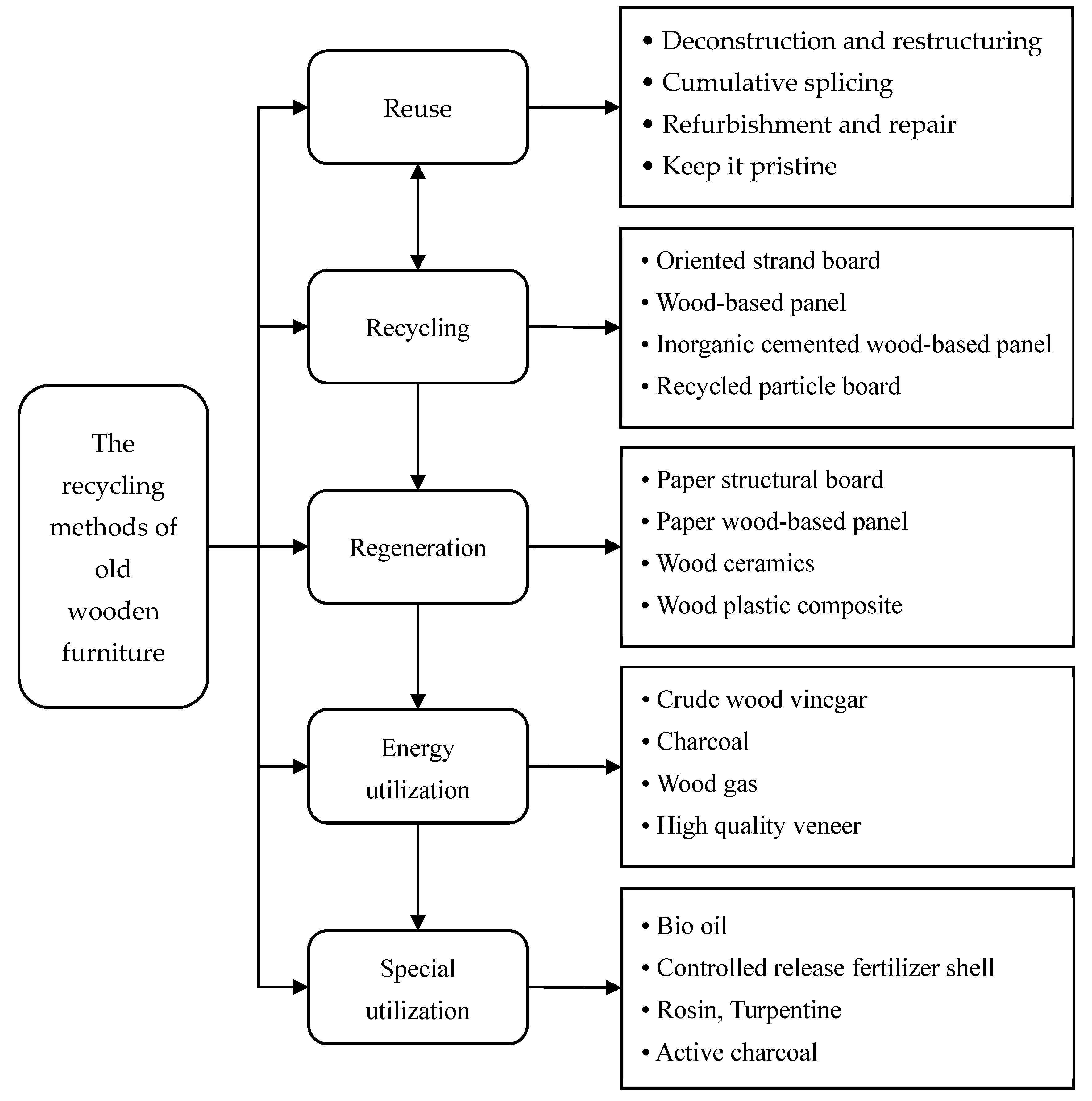

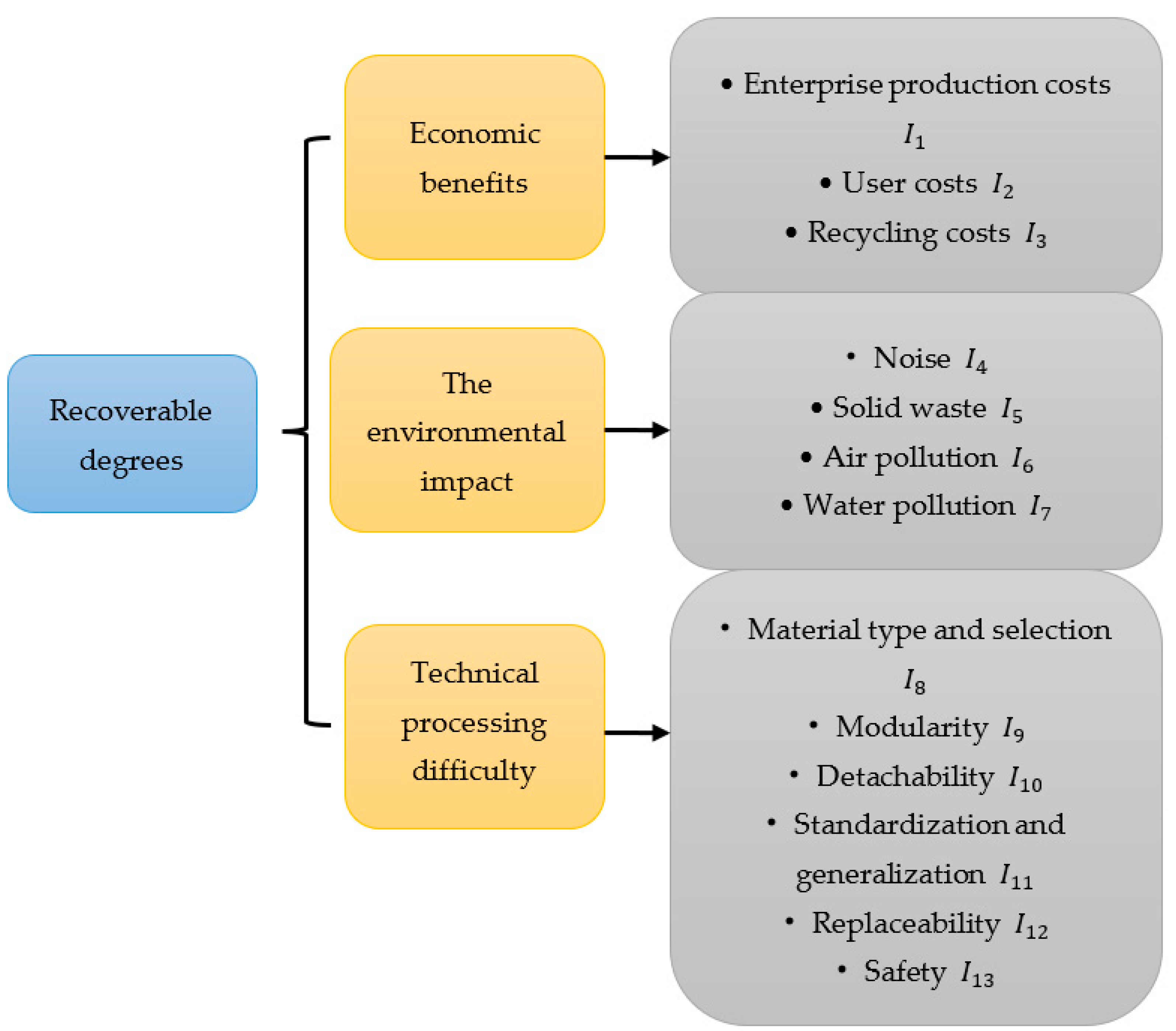
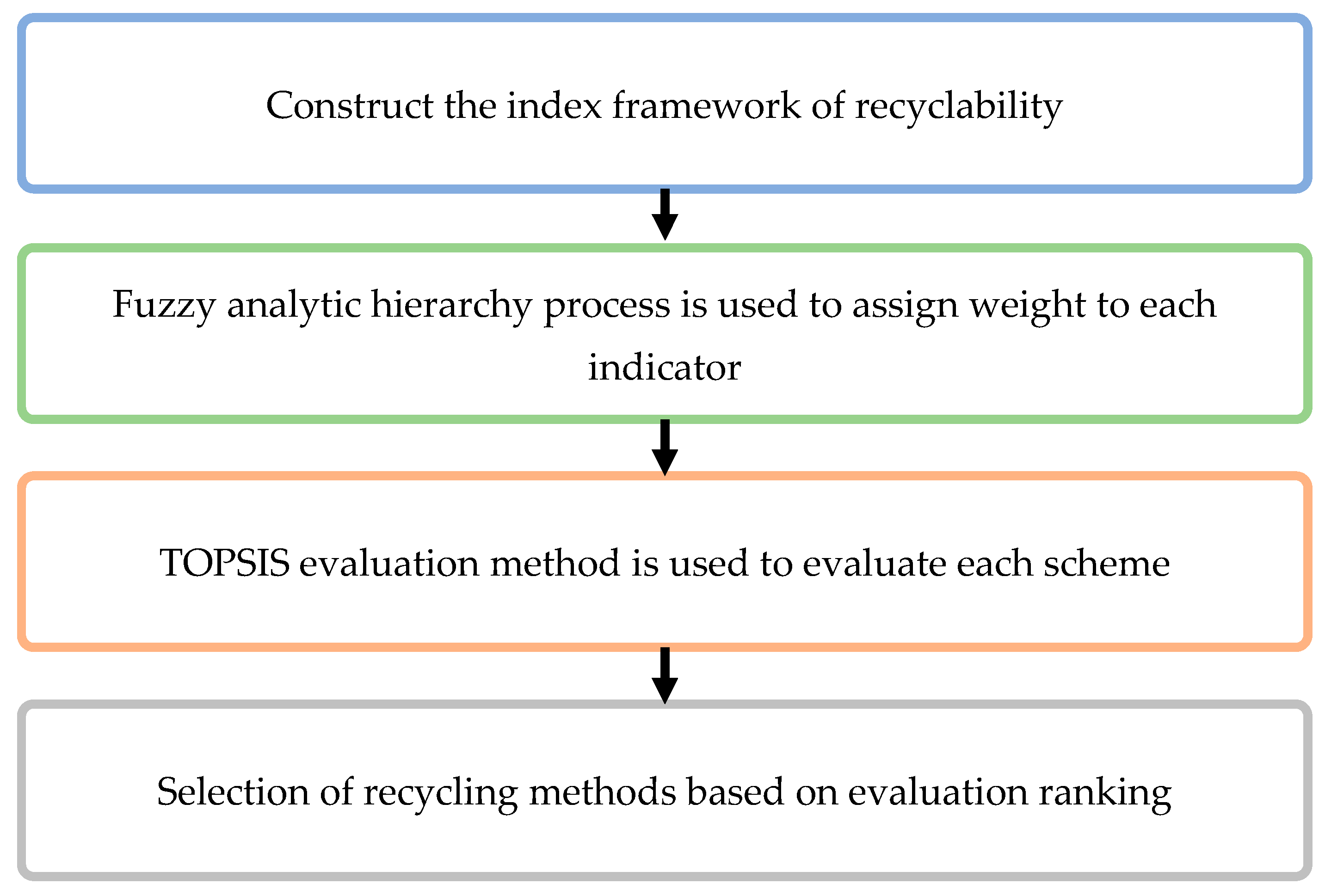
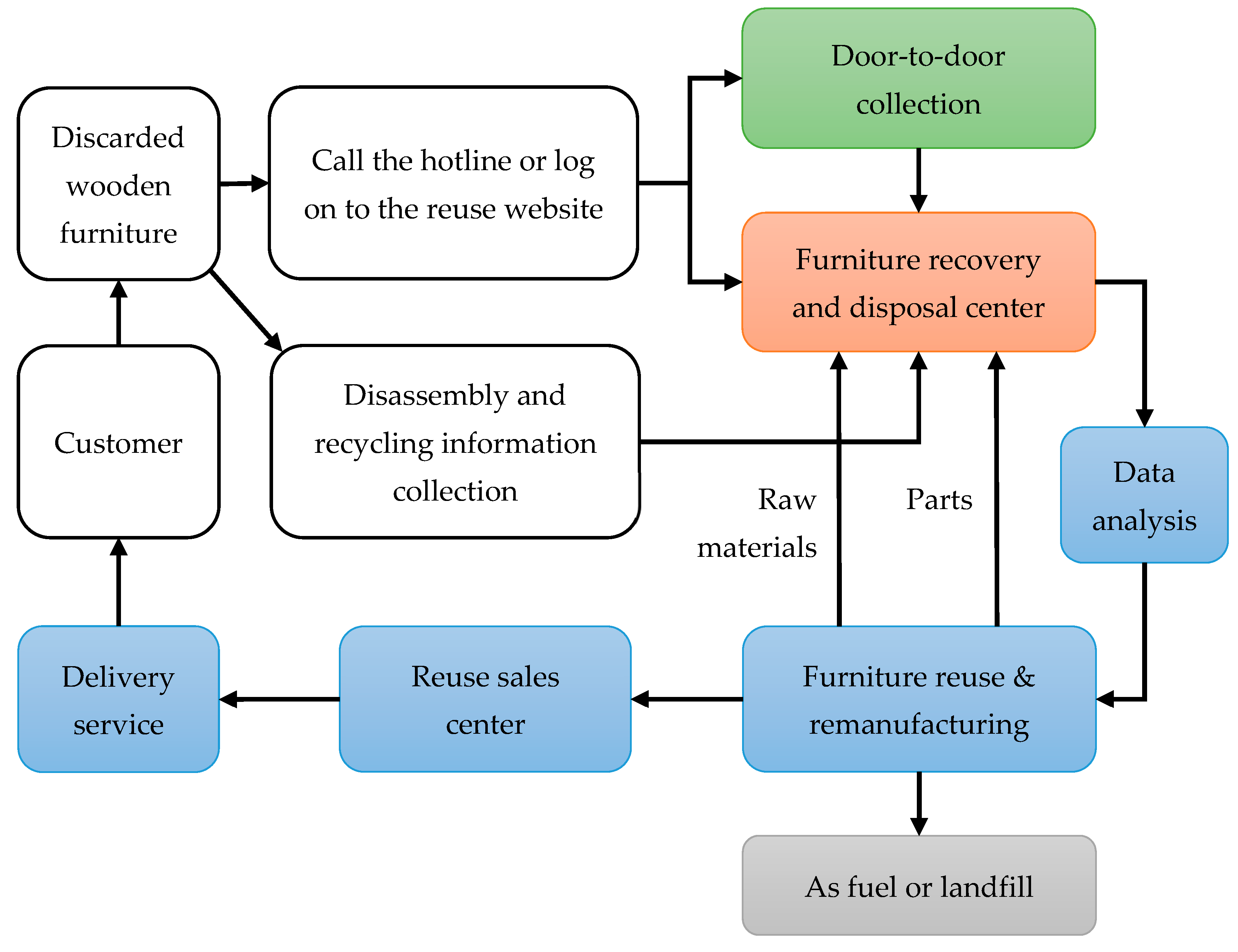
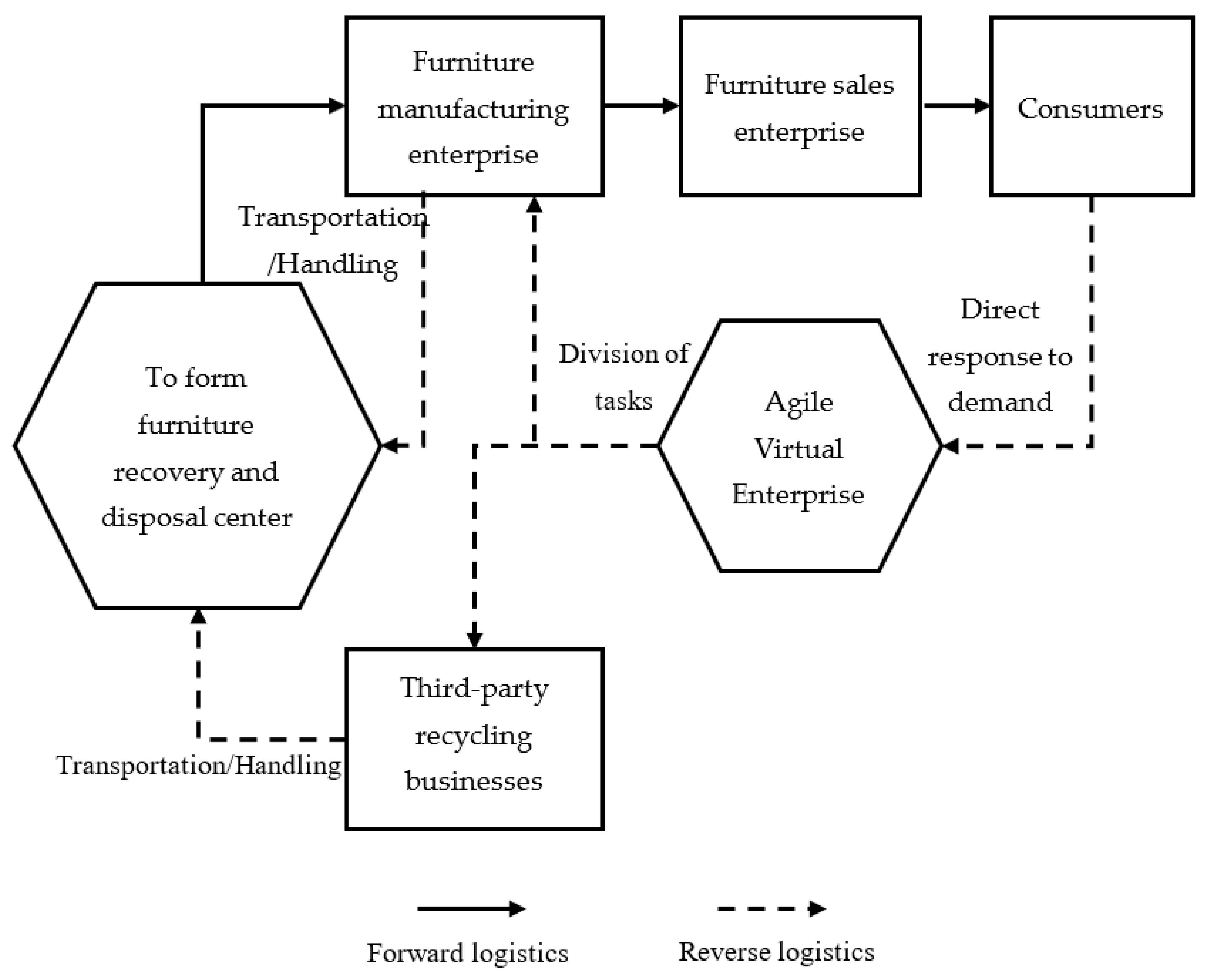
| Scale | Definition | Explanatory Notes |
|---|---|---|
| 1 | Important | while comparing two elements, is more important than |
| 0.5 | Equally important | while comparing two elements, and are equally important |
| 0 | Unimportant | while comparing two elements, is less important than |
| Judgment Indicator | Triangular Fuzzy Number |
|---|---|
| Very low (VL) | (0,0,0.1) |
| Low (L) | (0,0.1,0.3) |
| Medium low (ML) | (0.1,0.3,0.5) |
| Medium (M) | (0.3,0.5,0.7) |
| Medium high (MH) | (0.5,0.7,0.9) |
| High (H) | (0.7,0.9,1) |
| Very high (VH) | (0.9,1,1) |
| Indicator | Weight Value |
|---|---|
| weight vector | |
| Normalized weight vector | |
| weight vector | |
| Normalized weight vector | |
| weight vector | |
| Normalized weight vector | |
| weight vector | |
| Normalized weight vector |
| I1 | I2 | I3 | I4 | I5 | I6 | I7 | I8 | I9 | I10 | I11 | I12 | I13 | |
|---|---|---|---|---|---|---|---|---|---|---|---|---|---|
| P1 | MH | H | VL | ML | L | VL | VL | L | H | MH | MH | H | MH |
| P2 | H | MH | M | MH | H | ML | ML | L | M | H | VH | MH | M |
| P3 | L | ML | H | ML | M | MH | MH | VH | VL | L | VL | VL | M |
| P4 | L | L | VH | ML | ML | VH | VH | MH | VL | VL | VL | VL | MH |
Disclaimer/Publisher’s Note: The statements, opinions and data contained in all publications are solely those of the individual author(s) and contributor(s) and not of MDPI and/or the editor(s). MDPI and/or the editor(s) disclaim responsibility for any injury to people or property resulting from any ideas, methods, instructions or products referred to in the content. |
© 2023 by the authors. Licensee MDPI, Basel, Switzerland. This article is an open access article distributed under the terms and conditions of the Creative Commons Attribution (CC BY) license (https://creativecommons.org/licenses/by/4.0/).
Share and Cite
Zhang, Z.; Zhu, J.; Qi, Q. Research on the Recyclable Design of Wooden Furniture Based on the Recyclability Evaluation. Sustainability 2023, 15, 16758. https://doi.org/10.3390/su152416758
Zhang Z, Zhu J, Qi Q. Research on the Recyclable Design of Wooden Furniture Based on the Recyclability Evaluation. Sustainability. 2023; 15(24):16758. https://doi.org/10.3390/su152416758
Chicago/Turabian StyleZhang, Zhuoyu, Jiangang Zhu, and Qian Qi. 2023. "Research on the Recyclable Design of Wooden Furniture Based on the Recyclability Evaluation" Sustainability 15, no. 24: 16758. https://doi.org/10.3390/su152416758
APA StyleZhang, Z., Zhu, J., & Qi, Q. (2023). Research on the Recyclable Design of Wooden Furniture Based on the Recyclability Evaluation. Sustainability, 15(24), 16758. https://doi.org/10.3390/su152416758






